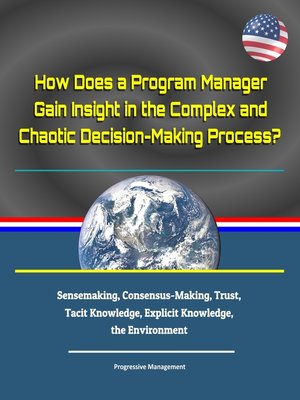How Does a Program Manager Gain Insight in the Complex and Chaotic Decision-Making Process? Six Categories
ebook ∣ Sensemaking, Consensus-Making, Trust, Tacit Knowledge, Explicit Knowledge, the Environment

Sign up to save your library
With an OverDrive account, you can save your favorite libraries for at-a-glance information about availability. Find out more about OverDrive accounts.
Find this title in Libby, the library reading app by OverDrive.



Search for a digital library with this title
Title found at these libraries:
| Loading... |
This excellent and interesting report has been professionally converted for accurate flowing-text e-book format reproduction. Leaders are inundated with complex decisions in chaotic environments that have ripple effects across any organization. This project studies Department of Defense program managers to better understand how a program manager creates situational awareness and understanding in chaotic program environments. Using qualitative research and conducting face-to-face interviews, this project focuses on how program managers gain insight in the decision-making process. This study provides a greater level of insight into these issues and will be the basis of future research. This study focuses on the emergence of six categories—sensemaking, consensus-making, trust, tacit knowledge, explicit knowledge, and the environment. Understanding the fundamental principles that guide decision-making will help program managers make sense of complex and chaotic program environments.
This compilation includes a reproduction of the 2019 Worldwide Threat Assessment of the U.S. Intelligence Community.
The U.S. Department of Defense (DoD) has been managing weapons acquisition in support of war efforts dating back to the Second Continental Congress and the Revolutionary War. Since then, the acquisition process has become significantly more complex, morphing into a systematic process with phases, events, and a plethora of rules, regulations, laws, and statutes. Today, the DoD is one of the largest and most complex businesses in the world. It employs over three million people; has a budget of nearly $640 billion; manages plants, property, and equipment at over 5,000 different locations worldwide; and uses over 30 million acres of land. The DoD's mission is to defend the homeland, deter war, and if necessary, defeat adversaries anywhere, anytime by land, sea, or air. In pursuit of this mission, the DoD equips the force with the most cutting-edge, disruptive, and leap-ahead technologies and instruments of war. The DoD program manager is responsible to lead this process. The program manager's job is to manage defense acquisition programs from cradle to grave and acquire technologies at the lowest cost and in a timely manner, while achieving the highest levels of technical performance.
I. Introduction * A. Background * B. Purpose Statement * C. Problem Statement * D. Scope * E. Method * II. Literature Review * A. Chapter Overview * B. History of Decision-Making * C. Sensemaking * D. Cynefin Framework * E. Intuitive and Analytical Decision-Making * F. Dual Process Theory * G. Naturalistic Decision-Making * H. Characteristics of Naturalistic Decision-Making * I. Organizational Decision-Making * J. Klein's RPD Model * K. Rasmussen's Decision Processes * L. Chapter Summary * III. Data * A. Chapter Overview * B. Subject A—Interview Summary * 1. Sensemaking * 2. Consensus-Making * 3. Trust * 4. Tacit Knowledge * 5. Explicit Knowledge * 6. Environmental Factors * C. Subject B—Interview Summary * 1. Consensus-Making * 2. Environment * 3. Sensemaking * 4. Trust * 5. Explicit Knowledge * 6. Tacit Knowledge * D. Chapter Summary * IV. Analysis * A. Chapter Overview * B. Examination * C. Hypotheses and Theories * 1. Hypothesis 1 * 2. Theory 1 * 3. Hypothesis 2 * 4. Theory 2 * D. Chapter Summary * V. Conclusion * A. Summary Of Research * B. Recommendations






